七宗罪英文电影赏析 ppt课件
- 格式:ppt
- 大小:18.99 MB
- 文档页数:46
![[精]电影赏析《七宗罪》](https://uimg.taocdn.com/60bc6ea5ddccda38366baf61.webp)
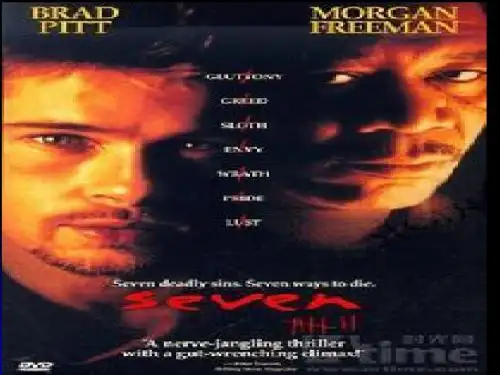
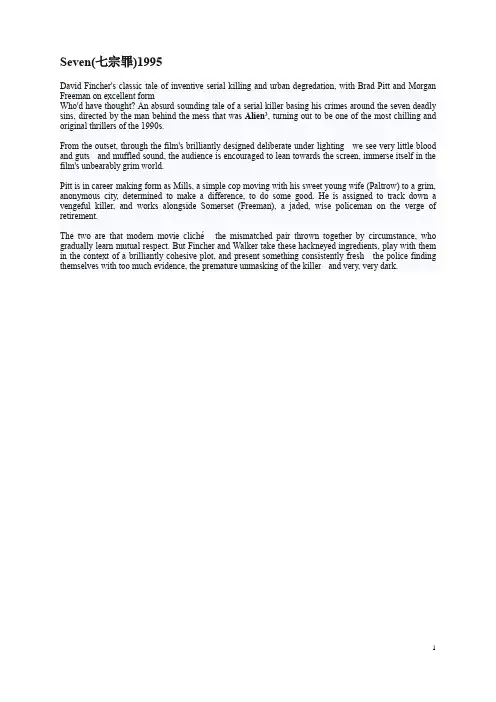
Seven(七宗罪)1995David Fincher's classic tale of inventive serial killing and urban degredation, with Brad Pitt and Morgan Freeman on excellent formWho'd have thought? An absurd-sounding tale of a serial killer basing his crimes around the seven deadly sins, directed by the man behind the mess that was Alien3, turning out to be one of the most chilling and original thrillers of the 1990s.From the outset, through the film's brilliantly designed deliberate under-lighting - we see very little blood and guts - and muffled sound, the audience is encouraged to lean towards the screen, immerse itself in the film's unbearably grim world.Pitt is in career-making form as Mills, a simple cop moving with his sweet young wife (Paltrow) to a grim, anonymous city, determined to make a difference, to do some good. He is assigned to track down a vengeful killer, and works alongside Somerset (Freeman), a jaded, wise policeman on the verge of retirement.The two are that modern movie cliché -the mismatched pair thrown together by circumstance, who gradually learn mutual respect. But Fincher and Walker take these hackneyed ingredients, play with them in the context of a brilliantly cohesive plot, and present something consistently fresh - the police finding themselves with too much evidence, the premature unmasking of the killer - and very, very dark.1。



任务分工:袁坤锋—人性分析;杨华伟—宗教分析;郭德君—两个警察和罪犯心理分析;张鹏—小警察人格分析;王义钦、潘棒—变态心理人性分析:《七宗罪》展示的就是如果丢掉信仰,世界将会怎样。
影片似乎只是在向世人展示:人性堕落,有罪之人会遭惩罚。
这部片子就有种道德劝诫的警世意味,让人看后可能反省自身是否有罪。
然而,什么原因让这些人产生罪恶,让凶手不可忍受而以上帝之名以杀戮的方式来进行惩戒,影片好像没有给出一个明确的解释。
是因为信仰的缺失吗?现在,以科学技术为核心的理性摧毁了宗教信仰精神,认为科学技术万能的人类觉得理性可以实现一切。
不错,以科学为代表的理性的确推动了西方社会的飞速进步,促其完成了现代化的过程。
可是,理性也越来越成为人们束缚自身的枷锁。
社会的发展越来越依赖诸如效率、计算、守时这些“理性化”的东西,这样的理性化其实就是一种“物化”,金钱和商业价值成为衡量一切价值的唯一尺度,人与人之间的关系由于金钱的厉害变得日益冷漠。
影片中,对现代城市的冷漠现实不断被展示。
比如威廉提到遇到强奸犯的女士不要喊救命要喊救火才会有人关注.老威廉的态度其实就是现代城市人的代表,他对这个世界很是厌恶,在目睹一场街边的抢劫案后钻进出租车,司机问他去哪里,他说:“远离这个鬼地方”他选择的态度是逃避。
这种心理在一次和大卫的酒吧谈话中被大卫揭穿,大卫还表示自己不会如此,知道这个世界的罪恶,但仍然坚持下去与它斗争。
威廉没有反对,他的想法的确如此,他意识到自己也应该积极面对这个世界,不能再逃避,所以他回家后砸掉了那个让他更感孤独的闹表。
并且最后警官问他退休后将要去哪里时,他说:“附近,我到附近走走。
”这部影片向人们展示了世界的罪恶和冷漠,但是没有告诉人们怎样避免这种境况的恶化。
是保持人性的善和对上帝的皈依吗?片子塑造的拥有美好人性的翠茜最后也被凶手残忍杀害。
片中展示的是世界最为阴暗的一面,对于美好光明温暖的一面完全遮蔽,大卫与翠茜的爱情尚且算作这个黑暗底色的一束光线,最后也由于翠茜的被杀而消逝.影片最后老警官威廉援引了海明威的一句话:这世界是个好地方,值得为它奋斗.后半部分我同意宗教分析:13世纪道明会神父圣多玛斯•阿奎纳列举出各种恶行的表现。

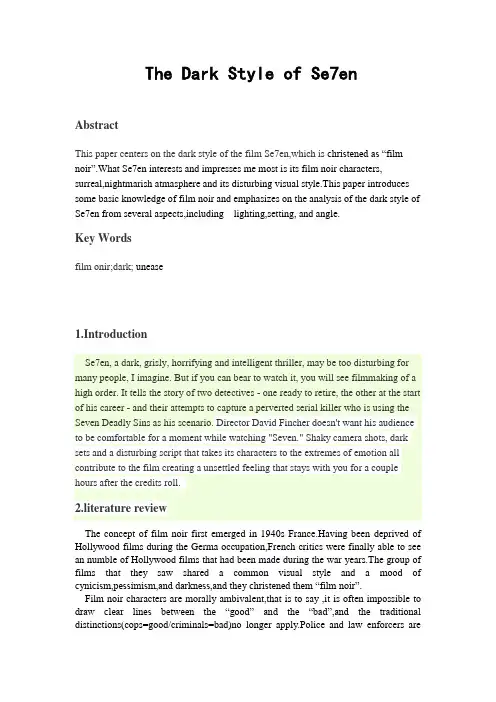
The Dark Style of Se7enAbstractThis paper centers on the dark style of the film Se7en,which is christened as “film noir”.What Se7en interests and impresses me most is its film noir characters, surreal,nightmarish atmasphere and its disturbing visual style.This paper introduces some basic knowledge of film noir and emphasizes on the analysis of the dark style of Se7en from several aspects,including lighting,setting, and angle.Key Wordsfilm onir;dark; unease1.IntroductionSe7en, a dark, grisly, horrifying and intelligent thriller, may be too disturbing for many people, I imagine. But if you can bear to watch it, you will see filmmaking of a high order. It tells the story of two detectives - one ready to retire, the other at the start of his career - and their attempts to capture a perverted serial killer who is using the Seven Deadly Sins as his scenario. Director David Fincher doesn't want his audience to be comfortable for a moment while watching "Seven." Shaky camera shots, dark sets and a disturbing script that takes its characters to the extremes of emotion all contribute to the film creating a unsettled feeling that stays with you for a couple hours after the credits roll.2.literature reviewThe concept of film noir first emerged in 1940s France.Having been deprived of Hollywood films during the Germa occupation,French critics were finally able to see an numble of Hollywood films that had been made during the war years.The group of films that they saw shared a common visual style and a mood of cynicism,pessimism,and darkness,and they christened them “film noir”.Film noir characters are morally ambivalent,that is to say ,it is often impossible to draw clear lines between the “good” and the “bad”,and the traditional distinctions(cops=good/criminals=bad)no longer apply.Police and law enforcers arefrequently corrupt,or at least corruptible; criminals and lawbreakers may emerge as sympathetic figures;and victims are often themselves also villains.The protagonist is no hero;instead,he is an all-too-human figure who may both perpetrate(as well as suffer)some appalling abuse in the course of the film.A surreal,nightmarish atmasphere characterizes film noir film.This mood is fostered by unexplained motives and confusing plot twists.It is often difficult to establish motives for characters’actions,and equally difficult to predict in which direction the plot will spin. The audience experiences the kind of uncertainty and disorientation,feeling in a dream.The overriding theme of film noir is a fear of the future..The mood of film noir is that of loss,nostalgia,and trepidation.3.Own analysisMuch of the distinctiveness of Se7en can be attributed to its skillful adaption of the conventions of film noir to the contemporary world.There is a common moral ambiguity,which casts heroes as potential villains and villains as potential heroes;a trepidation about the future and nostalgia for a more civilized world that exists only in the imagination;a puzzling and disturding narrative which andermines one’s expectations;and the characteristic noir style of perpetual rainfall,low-key lighting,and a subdued colour palette dominated by dullish grays,murky browns,and putrid.It is a classic film noir,but with a twist—a serial-killer narrative that raises import contemporary questions about the respective roles of morality,culture,and the media in our postmodern urban world.A central feature of most film noir and neo-noir is moral contradiction.It is frequently difficult to draw clear lines between good and bad,or state with certainty who it is that occupies the high maral ground.This is certainly the case with Se7en,in that neither Mills nor Somerset demonstrates unimpeachable standards.In their professional lives,for example,both are prepared to take immoral (and even illegal)measures to achieve their goal of arresting and prosecuting John Doe.Somerset bribes an associate in the FBI for access to the library records of borrowers—of course,the fact that the FBI even keeps such records is of questionable legality—and together they use this illegally gathered information to find out Doe’s address.When they reach his apartment,Mills simply kicksopen the door,rather than follow the correct and legal procedures,and first get hold of a search warrant.Aware that illegally gathered information would be invalid in a court of law,they then proceed to bribe an poor local resident to make up a story that will exculpate them.The victims of Doe’s cruel crimes are definitely no better.The obscenely fat man is an insult to human dignity;the greed of Elias Gould is fed by the money earned from defending rapists and murderers in court;Theodore Allen,punished for sloth,is actually a drug dealer and maker of horrific sexual crimes;the blonde woman is a prostitute in a seedy sex club;and the model was so vain that she could not live without her good looks.“The over-riding noir theme is a passion for the past and the present,but also a fear of the future.The noir hero dreads to look ahead,but instead tries to survive by theday,and if unseccessful at that,he retreats to the past.Thus film noir’s techniques emphasize loss,nostalgia,lack of clear priorities,insecurity;then submerge these self-doubts in mannerism and style.In such a world style becomes paramount;it is all that separates one from meaninglessness.”(Schrader,Paul.1999.Notes on Film Noir.) Se7en employs many of the classic film noir/neo-noir techniques to create its disturbing visual style.The main techniques and their effects are shown below.The look of "Seven" is crucial to its effect. This is a very dark film, the gloom often penetrated only by the flashlights of the detectives. Even when all the lights are turned on in the apartments of the victims, they cast only wan, hopeless pools of light. Gary Wissner, the art director, goes for dark blacks and browns, deep shadows, lights of deep yellow, and a lot of dark wood furniture. Film noir/neo-noir relies on the play of light and darkness for its characteristically oppressive mood,and se7en is no exception.To increase the luminosity of light tones and the density of the darks,director of photography for se7en,Darius Khondji,employed the seldom-used method of silver retention.The contrast is further exaggerated by the use of mise-en-scene:shadows,silhouettes,and flashlights probing into the envenoping darkness are the visual hallmarks of the film.Darkness thus becomes a symbol of that which is hidden beneath the surface;as Amy Taubin remarks,the film’s visuals”literalize the struggle of bringing things to light”.Yet while film noir/neo-noir tends to use darkness to create its sense of unease,this is not inevitably the case.In the final sequence,se7en relies not on darkness but on brightness—the scorching light of the desert—to induce asense of fearful anticipation.Khondji puts it this way,”For me,when I read the script,scary had to do with darkness.But it’s not always the case,sometimes it’s to do with a lot of light and no shadow at all```I thought that the scariest thing to suggest would be that there’s nowhere to hide.”As in most film noir/neo-noir,the setting is the city.Even when,in the final sequence,Mills and Somerset drive out into the desert,the city and its objects are never far away—it is theere in the pylons that ferry electricity to and fro,and it is there in the helicopter circling overhead.Scenes are generally filmed either indarkly lit interiors,or outside when it is raining.This predilection for city settings and dark interiors contributes to the prevailing mood of claustrophobia and entrapment.The low-angle shot is employed with great regularity,and has the effect of making buildings,ceilings,and human figures seem to loom down on the camera(and audience) in a sinister,theatening manner.Wide-angle lenses exaggerate this effect still further by distorting lines of positionally,lines are used to split the screen diagonally;they are used most prominently in this way in the final desert sequence where the electricity cables crisscross the screen.Se7en breaks the 189-degree rule in the scene in which Somerset and Mills drive Doe into the desert.One minute the camera is filming from the left,the next from the right,then from the back towards the front,and then from the front towards the back.This creates an effects of dislocation and visual confusion that is part of the overall sense of unease of film noir.“Even in close-ups,fencher keeps an uneasy distance(he favours low-angled shots,rather than eye-of-God overheads).The camera sometimes seems tofloat,sometimes seems dragged as if by sn undertow.The extremely shallow focus is a way of controlling the view’s eye,making you look at waht you don’t want to see an d suggesting that there;s something worse that you just can’t get a grip on lurking on the periphery.”(Taubin,Amy.2000.The Allure of Decay.)4.ConclusionAll in all,Se7en deserves all the reputation it has received.It gives us such a shock by successfully employing many of the classic film noir/neo-noir techniques.Its lighting,settings,shotting and scenes all together make the film worthy of the name of perfection.Bibliography[1]Schrader,Paul. Notes on FilmNoir.Shanhai: Shanhai Foreign Language Education Press,1999[2]Taubin,Amy.The Allure of Decay.Shanhai: Shanhai Foreign Language Education Press,2000[3] 马爱英(Ma Aiying).《中英文化翻译》.北京:科学出版社,2006。
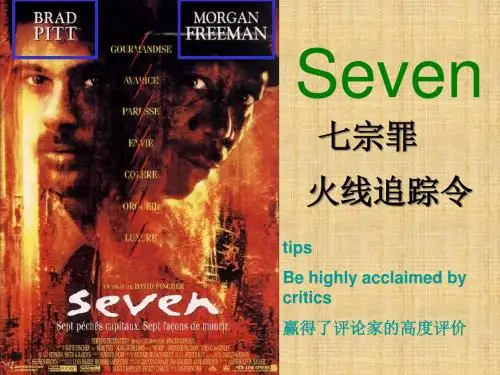
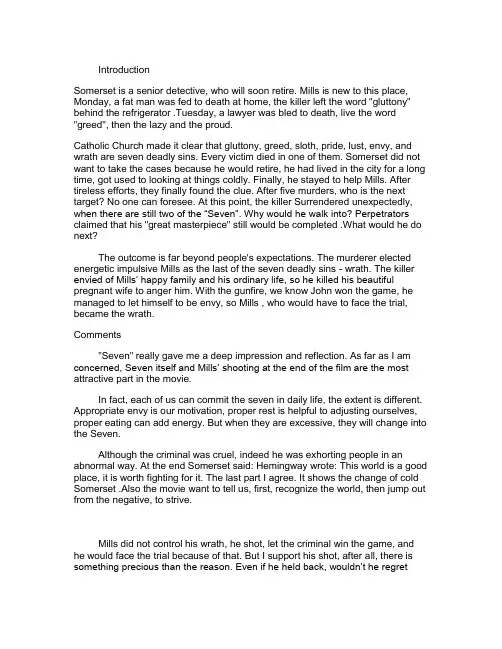
IntroductionSomerset is a senior detective, who will soon retire. Mills is new to this place, Monday, a fat man was fed to death at home, the killer left the word "gluttony" behind the refrigerator .Tuesday, a lawyer was bled to death, live the word "greed", then the lazy and the proud.Catholic Church made it clear that gluttony, greed, sloth, pride, lust, envy, and wrath are seven deadly sins. Every victim died in one of them. Somerset did not want to take the cases because he would retire, he had lived in the city for a long time, got used to looking at things coldly. Finally, he stayed to help Mills. After tireless efforts, they finally found the clue. After five murders, who is the next target? No one can foresee. At this point, the killer Surrendered unexpectedly, when there are still two of the “Seven”. Why would he walk into? Perpetrators claimed that his "great masterpiece" still would be completed .What would he do next?The outcome is far beyond people's expectations. The murderer elected energetic impulsive Mills as the last of the seven deadly sins - wrath. The killer envied of Mills’ happy family and his ordinary life, so he killed his beautiful pregnant wife to anger him. With the gunfire, we know John won the game, he managed to let himself to be envy, so Mills , who would have to face the trial, became the wrath.Comments"Seven" really gave me a deep impression and reflection. As far as I am concerned, Seven itself and Mills’ shooting at the end of the film are the most attractive part in the movie.In fact, each of us can commit the seven in daily life, the extent is different. Appropriate envy is our motivation, proper rest is helpful to adjusting ourselves, proper eating can add energy. But when they are excessive, they will change into the Seven.Although the criminal was cruel, indeed he was exhorting people in an abnormal way. At the end Somerset said: Hemingway wrote: This world is a good place, it is worth fighting for it. The last part I agree. It shows the change of cold Somerset .Also the movie want to tell us, first, recognize the world, then jump out from the negative, to strive.Mills did not control his wrath, he shot, let the criminal win the game, and he would face the trial because of that. But I support his shot, after all, there is something precious than the reason. Even if he held back, wouldn’t he regretwhen it was over? The tragic lens and ending touched me deeply, and tell me to cherish something I have overlooked previously.CultureThe film describes a very religious philosophical crime story, so that we know the Western religious culture from another point of view.Seven, the name of the movie is significant. Chinese and Western culture seems to have completely different message to the figure. In Chinese culture, "seven" represents light, luck and joy. While in the West, "seven" is related t o religions and human sin, very mysterious and even secretive. Gluttony, greed, sloth, lust, pride, envy and wrath, was seven deadly sins considered by the Catholic.In the movie, 7 sins, 7 penalties, 7 rain, the story took place in 7 days, and even the ending was determined by the criminal, seven days at 7 pm. Just implie that: Seven is the crime and punishment of the fate. And let us know the power of religion.。
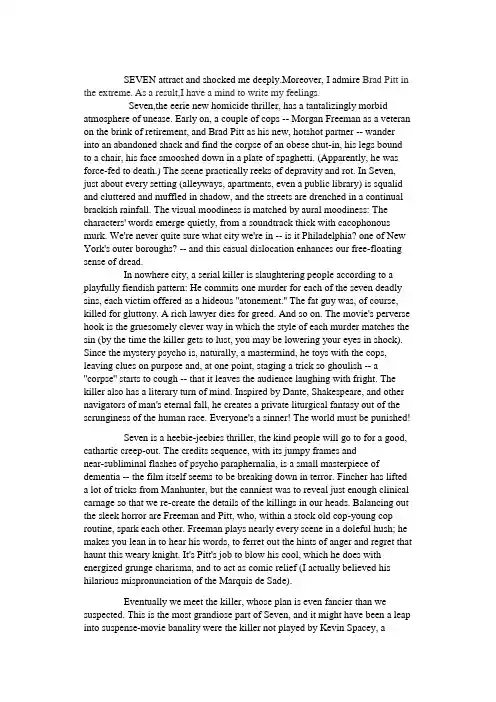
SEVEN attract and shocked me deeply.Moreover, I admire Brad Pitt in the extreme.As a result,I have a mind to write my feelings.Seven,the eerie new homicide thriller, has a tantalizingly morbid atmosphere of unease. Early on, a couple of cops -- Morgan Freeman as a veteran on the brink of retirement, and Brad Pitt as his new, hotshot partner -- wander into an abandoned shack and find the corpse of an obese shut-in, his legs bound to a chair, his face smooshed down in a plate of spaghetti. (Apparently, he was force-fed to death.) The scene practically reeks of depravity and rot. In Seven, just about every setting (alleyways, apartments, even a public library) is squalid and cluttered and muffled in shadow, and the streets are drenched in a continual brackish rainfall. The visual moodiness is matched by aural moodiness: The characters' words emerge quietly, from a soundtrack thick with cacophonous murk. We're never quite sure what city we're in -- is it Philadelphia? one of New York's outer boroughs? -- and this casual dislocation enhances our free-floating sense of dread.In nowhere city, a serial killer is slaughtering people according to a playfully fiendish pattern: He commits one murder for each of the seven deadly sins, each victim offered as a hideous ''atonement.'' The fat guy was, of course, killed for gluttony. A rich lawyer dies for greed. And so on. The movie's perverse hook is the gruesomely clever way in which the style of each murder matches the sin (by the time the killer gets to lust, you may be lowering your eyes in shock). Since the mystery psycho is, naturally, a mastermind, he toys with the cops, leaving clues on purpose and, at one point, staging a trick so ghoulish -- a''corpse'' starts to cough -- that it leaves the audience laughing with fright. The killer also has a literary turn of mind. Inspired by Dante, Shakespeare, and other navigators of man's eternal fall, he creates a private liturgical fantasy out of the scrunginess of the human race. Everyone's a sinner! The world must be punished!Seven is a heebie-jeebies thriller, the kind people will go to for a good, cathartic creep-out. The credits sequence, with its jumpy frames andnear-subliminal flashes of psycho paraphernalia, is a small masterpiece of dementia -- the film itself seems to be breaking down in terror. Fincher has lifted a lot of tricks from Manhunter, but the canniest was to reveal just enough clinical carnage so that we re-create the details of the killings in our heads. Balancing out the sleek horror are Freeman and Pitt, who, within a stock old cop-young cop routine, spark each other. Freeman plays nearly every scene in a doleful hush; he makes you lean in to hear his words, to ferret out the hints of anger and regret that haunt this weary knight. It's Pitt's job to blow his cool, which he does with energized grunge charisma, and to act as comic relief (I actually believed his hilarious mispronunciation of the Marquis de Sade).Eventually we meet the killer, whose plan is even fancier than we suspected. This is the most grandiose part of Seven, and it might have been a leap into suspense-movie banality were the killer not played by Kevin Spacey, adevious ham who uses his aging little-boy face to hypnotic deadpan effect. He's like the world's most demonic sissy. The climactic sequence is powered by a visual coup -- Fincher takes the movie out of gloomsville and into a sun-dappled field of electric wires -- but mostly by Spacey's mischievous core of masochism. It's Seven's nastiest stroke of wit that, by the end, what he wants and what the audience wants turn out to be one and the same.。
老:Get out of the van! 从车里出来!Out ! 出来!递:Jesus Christ, man. Don’t shoot me. 天哪,老兄。
不要开枪。
老:Step away. 离车远点。
Turn around. Put your hands on your head. 转过去,手抱头。
(飞:What the hell is going on? 到底发生了什么?)老:Why and what are you doing here? 你为什么来这里?递:I’m delivering a package man. 我只是送快递而已。
I got a package for this guy, David. 我有个快递要送给戴维。
Detective... 警探David Mills. 戴维•米尔斯老:Get it. Slowly. 拿过来。
慢一点。
(飞:He’s opening the back of van. 他正在打开火车的后备箱。
We’ve got him in sight. 我们瞄准他了。
)递:This guy paid me ﹩500 to bing it out here, man.有人出500块让我把它带过来。
He said he wanted it here at exactly 7 o’clock.他让我在7点钟准时送到。
老:Put it down. 放下来。
We got a box 我们有个盒子。
(飞:We got a box . Call the bomb squad. 有一个盒子,快找拆弹组。
Bomb squad . We got a box . 拆弹组,我们这有个盒子。
)老:Face the van. 面朝货车。
Hands up. 举起手来。
Turn around . 转过来。
Okay. Go. 好的,快走。
Off you go. Go . 快离开这里。
快。
I’m sending the driver out on foot . 我让司机跑着离开了。